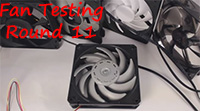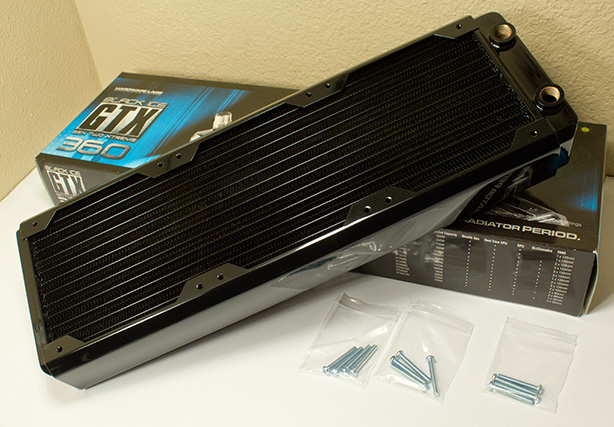This is the sixth in my series of triple radiators the HardwareLabs GTX 360. We looked at the slow speed fan optimized premium double thickness SR-1 already, and the GTX is premium radiator designed for high-speed fans. The GTX also employs a completely different core and fin technology using ultra slim tubes, split fin technology, and a unique front to back two pass system that really no other radiator uses.
A special thanks to Dennis and Jeremy from Danger Den for providing the review sample:
DangerDen & HWlabs Specifications:
http://www.dangerden.com/store/black-ice-gtx360.html
http://www.hwlabs.com/index.php?option=com_content&view=article&id=14&Itemid=11
The Black Ice® GTX360 is indeed a generational revolution from its traditional Xtreme case-mod professional origins. True second generation Black Ice GTX core design maximizes cooling, flowrates and peformance utilizing 3 x 120mm fans even in low RPM/noise conditions. Xtreme level performance, as expected comes with at the highest quality of design and construction to cater to the most discerning case-mod enthusiast.
FEATURES
- Two-pass pre-cool/aftercool front-rear dual-core flow configuration with a 30% increase in internal flow rates.
- Custom MaxFin™ 25 micron Copper Splitter Fin Configuration utilizing 45% thinner fin material yielding up to 50% less pressure drop.
- Unique fin configuration eliminates intra-louver accumulation of dust particles for trouble-free operation.
- Radically optimized 20 FPI (Fins Per Inch) fin density providing dramatically increased heat transfer surface area.
- Custom low-profile 2-row 19.0 x 1.2mm MaxFlow™ tubes with twice the waterside surface area of the GTS and 60% frontal area reduction for superior low air-resistance aerodynamics and lower internal flow requirements.
- Yields up to 45% more heat exchange capacity than the Black Ice® Xtreme in both Stealth or Performance modes.
- Achieves Black Ice® Xtreme level performance in stealth mode (low-noise/low-airflow conditions).
- M4 Threaded Screw Holes for easier mounting and greater adaptability.
- Now standard G 1/4″ female threaded fittings.
- Full high-temper brass structural construction for weight reduction and superior corrosion resistance.
- High performance compact radiator compatible as an upgrade to the Black Ice® Xtreme and most 120mm form factor radiators.
- Uses 100% Non-corrosive water-solluble fluxing process.
- Fully RoHS compliant.
- Full electrostatic polyurethane painting finish for uniform coating with high temperature curing for increased finish durability.
- Renowned Black Ice® quality.
- Patent Pending Design.
DIMENSIONS
Width133 mmHeight397 mmThickness54 mm



Nice review man, I really appreciate the time and effort you put into these reviews.
Cool massive necropost bro… [not]
Sorry, I ended up loosing a bunch of comments in my post mismanagement. There was some more active stuff in many of these posts and I had a mishmash of posting allowed or not. I finally figured out how to take them all and open up the comments again.
My fault..:)
@Martin
Eh?
The comments were all messed up and deleted on accident before which is why it look a bit empty is all.
Hi Martin,
The pressure drop curve is very unusually linear for this rad. I find yhst simply weird and illogical. Restriction dhould increase exponentially as flow increases, not in a linear manner. This brings me to beleive maybe something was off in your testing this one?!?!
I thought so too the first time I did a GTX, but it is correct, skinnee got the same flat curve. The only thing I can think of is the GTX uses unusually thin and flat tubes and as pressures increase these tubes must flex to the point of flattening the curve.
All of the GTX pressure drop tests have this same sort of flat response. Goes to show you not everything behaves theoretically though and there is probably some minor differences with some CPU blocks when mounted under bowing pressure vs free standing testing.